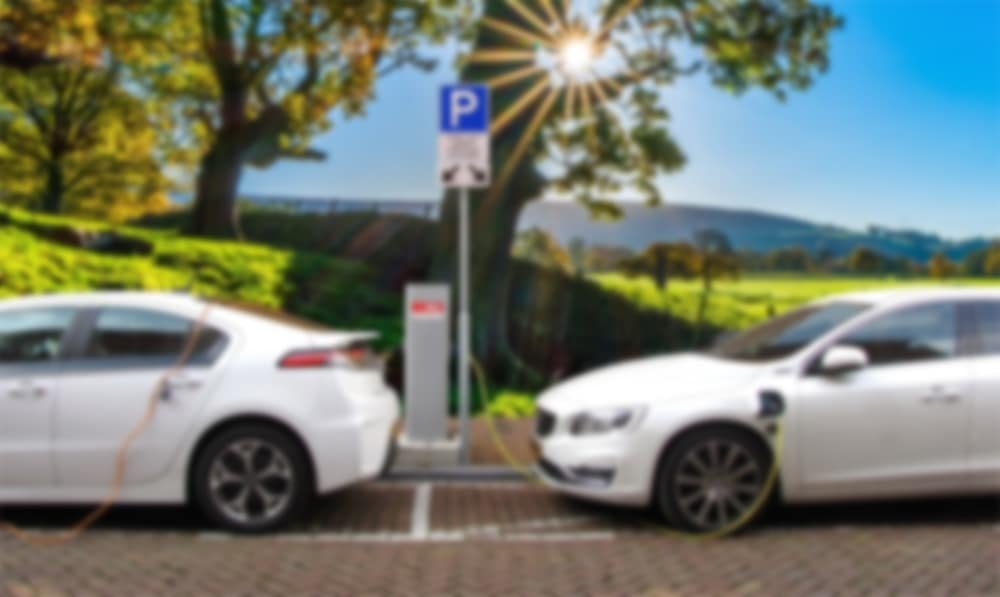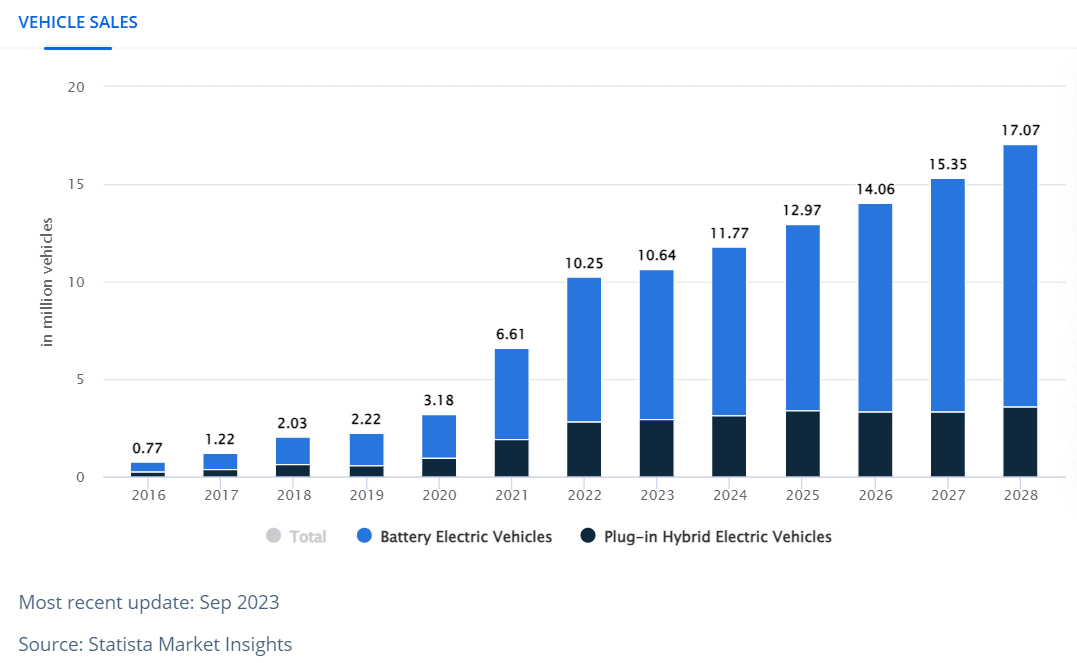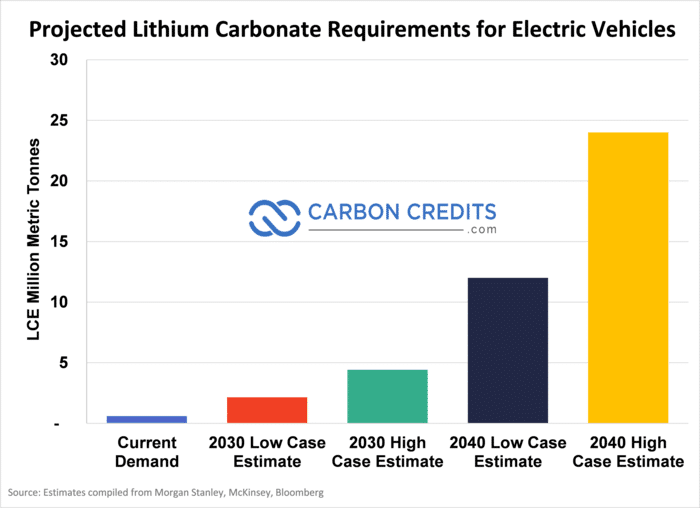In a bid to reshape the transportation landscape, the United States government has committed a staggering $623 million to propel the growth of electric vehicles (EVs). Across the Atlantic, Ireland is stepping into the limelight with promising lithium discoveries, aiming to bolster Europe’s battery supply chain.
The dynamics of these groundbreaking developments will have a potential impact on the future of sustainable mobility.
Empowering EVs in the US
The Biden administration grants, available through the 2021 Bipartisan Infrastructure Law, are geared towards supporting the increasing deployment of EVs.
Currently, there are over 4 million electric vehicles on the American roads, as per the U.S. Transportation Department’s data. But progress on the EV charging network has been slow. Only New York and Ohio have charging stations in operation.
Meanwhile, Pennsylvania and Maine are expected to open EV charging stations early this 2024.
EV Unit Sales 2016-2028
Last year, a total of around 11 million EV units were sold globally, according to Statista. This year, the EV market, including both battery and plug-in hybrid, would reach a staggering $623 billion in sales worldwide. Such a massive growth will lead to a market volume of $906 billion by 2028, reaching 17 million vehicle units.
With the grant, the U.S. aims to make EV chargers more accessible, reliable, and convenient for American drivers. Plus, this will also generate jobs in charger manufacturing, installation, and maintenance.
Of the total amount, $311 million from the Federal Highway Administration will support 36 community projects, including EV charging and hydrogen fueling infrastructure.
The remaining $312 million will go to 11 recipients for projects along designated alternative fuel corridors. In total, the grants will fund 47 EV charging and alternative-fueling infrastructure projects across 22 states and Puerto Rico. Overall, this would lead to the construction of approximately 7,500 EV charging ports.
The recipients include the North Central Texas Council of Governments, the New Jersey Department of Environmental Protection, and the Maryland Clean Energy Center.
The funds are part of the $2.5 billion Charging and Fueling Infrastructure Discretionary Grant Program under the infrastructure law. The regulation has a broader goal of installing 500,000 EV charging stations in the U.S. by 2030.
Since January 2021, EV sales have quadrupled, and publicly available charging ports have increased by 70%, per the Transportation Department. That figure is only ⅓ of the way to the current administration’s goal, with 6 years left.
What all these bullish projections mean is more requirement for lithium and Europe is also ramping up its lithium exploration. As seen below, projected lithium requirements for EV needed by 2040 is nearly 25 million metric tonnes.
Ireland’s Lithium Odyssey
Back in 1972, Irish Base Metals Ltd. identified traces of lithium in local granites during base metals exploration. However, the potential significance was overlooked at the time, as lithium was deemed “not of interest” and “not really a commercial mineral,” according to John Teeling, a former key adviser to Irish Base Metals.
The EU, heavily dependent on Australia for 87% of its raw lithium imports, is now keen on expanding exploration. The bloc’s Critical Raw Materials Act is supporting this move. The EU-backed GreenPeg project has considered southeast Ireland as one of 3 locations to study pegmatite ore deposits.
-
Pegmatite lithium deposits is also known as hard-rock lithium deposits, containing extractable amounts of a number of elements, including lithium,
Ireland is historically significant as Russia’s 3rd-largest alumina supplier in 2022. It is also home to Europe’s largest zinc-producing mine. However, recent mineral exploration has primarily focused on other resources like copper, lead, zinc, and gold.
S&P Global Market Intelligence data indicates only 2 established lithium projects in the country, Avalonia (Carlow) and Leinster (Wicklow).
John Harrop, senior project geologist at Canadian consultancy Coast Mountain Geological Group, which works on the Avalonia project, highlighted that:
“If exploration is successful in Ireland, it is more likely to contribute a number of small- to medium-size lithium bodies similar to the clusters that are being explored and discovered elsewhere in Europe.”
Harrop envisions Ireland becoming a contributor to lithium supply feeds for upcoming lithium processing plants in Europe. He further emphasized the potential for more discoveries in the Irish lithium belt.
Arkle Resources, in a new lithium exploration effort, discovered pegmatites in its Mine River gold project in November 2022. This area is west of the Avalonia project, a joint venture established in 2014 by Canada’s International Lithium Corp. and China’s Ganfeng Lithium Group.
These developments come as Ireland faces challenges in building a lithium sector. These particularly include a shortage of skilled professionals experienced in recognizing hard rock lithium.
One of the companies best prepared to take advantage of the looming shortage of lithium is Li-FT Power (LIFT; LIFFF). It is the fastest developing North American lithium junior, with 5 different projects across Canada.
As the wheels of innovation turn, the convergence of substantial investments in EV infrastructure and Ireland’s lithium exploration signals a transformative era. The electrification of transport and the pursuit of sustainable energy solutions will shape the global landscape in unprecedented ways. The road ahead is charged with potential, both electric and lithium-powered.
Disclosure: Owners, members, directors, and employees of carboncredits.com have/may have stock or option positions in any of the companies mentioned: LIFT.
Carboncredits.com receives compensation for this publication and has a business relationship with any company whose stock(s) is/are mentioned in this article.
Additional disclosure: This communication serves the sole purpose of adding value to the research process and is for information only. Please do your own due diligence. Every investment in securities mentioned in publications of carboncredits.com involves risks that could lead to a total loss of the invested capital.



